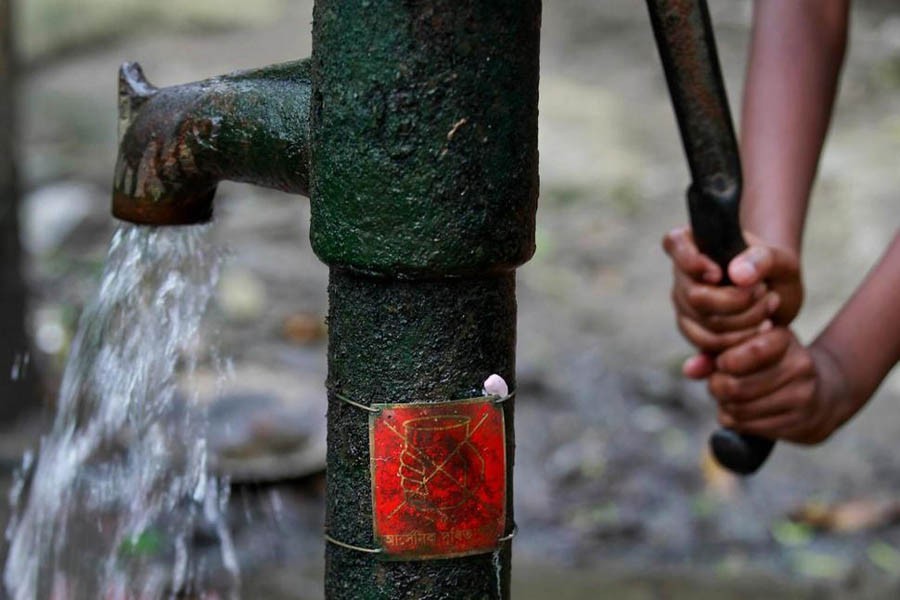
Published :
Updated :

Water, water everywhere not a single drop to drink. Right now, there is perhaps no shortage of water per se in Southern part of Bangladesh. But pure drinking water is acutely short. The climate change causing salt intrusion into water, has contributed to worsening the situation. Recent newspaper reports on water scarcity in Southern Bangladesh and its ramifications is worth pondering. Drawing upon available researches hither and thither, we can possibly calculate the cost of arsenic.
Many years back, the country was attacked by a deadly disease called arsenic from tube well water. Arsenic is not merely the name of a disease but one of the drivers of devastation in Bangladesh. Although exposure to arsenic through drinking water sourced from groundwater is a global public health problem, researchers reveal from survey data from 2000 to 2010 that an estimated 35 to 77 million people in the country have been chronically exposed to arsenic in their drinking water. This has been described as the largest mass poisoning in history
The researchers have attempted to reach an estimate of the economic losses resulting from the arsenic-related mortality burden. They have calculated lost productivity in terms of per capita gross domestic product (GDP). According to estimates by the International Monetary Fund, the per capita GDP for Bangladesh in 2009 was 1,465 purchasing power parity dollars. "If we assume steady economic growth and an average loss of 10 years of productivity per arsenic-attributable death, over the next 20 years arsenic-related mortality in Bangladesh (1 of every 18 deaths) could lead to a loss of US$ 12.5 billion, provided arsenic exposure (> 10 ?g/L) remains the same as in 2009. Our assumption of an average loss of 10 years of productivity per arsenic-attributable death was based on lost productivity owing to deaths from types of cancer known to be arsenic-related."
Given the same assumptions, a "quick and dirty" calculation would show that the total loss in 2017 would tentatively be $36 billion (roughly one-fifths of GDP). In other words, losses from arsenic would be closer to the returns from ready-made garments exports in a year. It is simply a colossal loss that a nation can hardly afford. There is another point to ponder - "Because the loss in GDP attributable to deaths does not take into account health costs or other costs to society, it probably underestimates the full economic burden. This burden can be expected to grow as the country develops and life expectancy rises. The morbidity burden will also increase as diagnostic tests improve and better treatment methods prolong the lives of people with chronic arsenic-related disease, and the costs of medical care will increase in tandem."
The non-calculated hidden costs of the disease are no less damaging. It is expected that arsenic-related diseases and deaths will increase in the future because the latency period after exposure lasts several decades. "Studies on chronic arsenic exposure in utero and in early childhood suggest an increased risk of fetal loss, infant death, reduced birth weight and impaired cognitive function in children, as well as significantly higher risks of impaired lung function, renal cancer and death from lung cancer, lung disease and acute myocardial infarction later in life. Since an entire generation has now grown up exposed to arsenic, some children will become "arsenic orphans" as their caretakers succumb to arsenic-related diseases. These children may also be exposed to arsenic themselves, which would perpetuate the cycle of arsenic-related disease."
It is also illustrative to examine the impact of arsenic exposure on children not yet born. The future health of this segment, as shown by several studies, will be affected by the concentration of arsenic in the water they begin drinking in uterus. This exercise shows that any population-level reduction in arsenic exposure will result in decreased arsenic-related morbidity and mortality among children yet to be born. Similarly, any failure to sustain progress in arsenic mitigation will result in deaths that could have been prevented among members of future generations. However, because of uncertainty and individual variation in arsenic exposure and the latency period before disease onset, these analyses are qualitative and semi-quantitative predictions at best.
It is true that due to various measures adopted by the government, NGOs and private sector over time, the incidence of arsenic exposure has apparently gone down, but a deep dive to the actual determinants would possibly leave less room for consolation. The government should continue to invest more in arsenic mitigation through building partnership with private sector and NGOs. "The effectiveness of such an approach was demonstrated during the United Nations Children's Fund 2006-2011 country programme, which provided safe water to arsenic-contaminated areas at a cost of US$ 11 per capita. National scale-up of such an approach would cost a few hundred million US dollars but would improve the health and productivity of the population, especially in future generations." Further, special credit arrangements should be made available for small and medium enterprises to establish water purifying centres. Like water market for irrigation, a private sector-led market for drinking water with a competitive face should form the basis of fighting against arsenic. Arsenic makes lives of the present generation short and shabby; it also founders the fruits of the future generation. The sooner we realize this reality, the better for us.
Apparently, it seems that we are out of the woods but actually not. Immediate measures need to be taken to face the problem.
Abdul Bayes is a former Professor of Economics at Jahangirnagar University.


 For all latest news, follow The Financial Express Google News channel.
For all latest news, follow The Financial Express Google News channel.